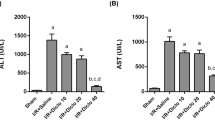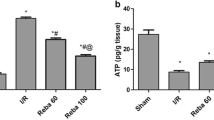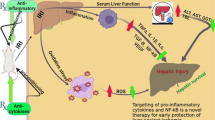Abstract
Background/Aims
The proton pump inhibitor lansoprazole (LPZ) is clinically used to reduce gastric acid secretion, but little is known about its possible hepatoprotective effects. This study aimed to investigate the hepatoprotective effects of LPZ and its potential mechanisms using in vitro and in vivo rat models of liver injury.
Methods
For the in vitro model of liver injury, primary cultured rat hepatocytes were treated with interleukin-1β in the presence or absence of LPZ. The influence of LPZ on inducible nitric oxide synthase (iNOS) induction and nitric oxide (NO) production and on the associated signaling pathways was analyzed. For the in vivo model, rats were treated with D-galactosamine (GalN) and lipopolysaccharide (LPS). The effects of LPZ on survival and proinflammatory mediator expression (including iNOS and tumor necrosis factor-α) in these rats were examined.
Results
LPZ inhibited iNOS induction partially through suppression of the nuclear factor-kappa B signaling pathway in hepatocytes, thereby reducing potential liver injury from excessive NO levels. Additionally, LPZ increased survival by 50% and decreased iNOS, tumor necrosis factor-α, and cytokine-induced neutrophil chemoattractant-1 mRNA expression in the livers of GalN/LPS-treated rats. LPZ also inhibited nuclear factor-kappa B activation by GalN/LPS.
Conclusions
LPZ inhibits the induction of several inflammatory mediators (including cytokines, chemokines, and NO) partially through suppression of nuclear factor-kappa B, resulting in the prevention of fulminant liver failure. The therapeutic potential of LPZ for liver injuries warrants further investigation.








Similar content being viewed by others
References
Stedman CA, Barclay ML. Review article: comparison of the pharmacokinetics, acid suppression and efficacy of proton pump inhibitors. Aliment Pharmacol Ther. 2000;14:963–978.
Bown RL. An overview of the pharmacology, efficacy, safety and cost-effectiveness of lansoprazole. Int J Clin Pract. 2002;56:132–139.
Satoh H. Discovery of lansoprazole and its unique pharmacological properties independent from anti-secretory activity. Curr Pharm Des. 2013;19:67–75.
Takagi T, Naito Y, Okada H, et al. Lansoprazole, a proton pump inhibitor, mediates anti-inflammatory effect in gastric mucosal cells through the induction of heme oxygenase-1 via activation of NF-E2-related factor 2 and oxidation of kelch-like ECH-associating protein 1. J Pharmacol Exp Ther. 2009;331:255–264.
Yoda Y, Amagase K, Kato S, et al. Prevention by lansoprazole, a proton pump inhibitor, of indomethacin -induced small intestinal ulceration in rats through induction of heme oxygenase-1. J Physiol Pharmacol. 2010;61:287–294.
Wakabayashi N, Dinkova-Kostova AT, Holtzclaw WD, et al. Protection against electrophile and oxidant stress by induction of the phase 2 response: fate of cysteines of the Keap1 sensor modified by inducers. Proc Natl Acad Sci USA. 2004;101:2040–2045.
Eggler AL, Gay KA, Mesecar AD. Molecular mechanisms of natural products in chemoprevention: induction of cytoprotective enzymes by Nrf2. Mol Nutr Food Res. 2008;52:S84–S94.
Numazawa S, Ishikawa M, Yoshida A, Tanaka S, Yoshida T. Atypical protein kinase C mediates activation of NF-E2-related factor 2 in response to oxidative stress. Am J Physiol Cell Physiol. 2003;285:C334–C342.
Keum YS. Regulation of the Keap1/Nrf2 system by chemopreventive sulforaphane: implications of posttranslational modifications. Ann NY Acad Sci. 2011;1229:184–189.
Shay KP, Moreau RF, Smith EJ, Smith AR, Hagen TM. Alpha-lipoic acid as a dietary supplement: molecular mechanisms and therapeutic potential. Biochim Biophys Acta. 2009;1790:1149–1160.
Hayes JD, McMahon M. Molecular basis for the contribution of the antioxidant responsive element to cancer chemoprevention. Cancer Lett. 2001;174:103–113.
Kawai H, Kudo N, Kawashima Y, Mitsumoto A. Efficacy of urine bile acid as a non-invasive indicator of liver damage in rats. J Toxicol Sci. 2009;34:27–38.
Ueda K, Ueyama T, Oka M, Ito T, Tsuruo Y, Ichinose M. Polaprezinc (Zinc L-carnosine) is a potent inducer of anti-oxidative stress enzyme, heme oxygenase (HO)-1—a new mechanism of gastric mucosal protection. J Pharmacol Sci. 2009;110:285–294.
Yamamoto Y, Tanahashi T, Kawai T, et al. Changes in behavior and gene expression induced by caloric restriction in C57BL/6 mice. Physiol Genomics. 2009;39:227–235.
Ueyama T, Yamamoto Y, Ueda K, et al. Is gastrectomy-induced high turnover of bone with hyperosteoidosis and increase of mineralization a typical osteomalacia? PLoS One. 2013;8:e65685.
Tanigawa T, Watanabe T, Higuchi K, et al. Lansoprazole, a proton pump inhibitor, suppresses production of tumor necrosis factor-alpha and interleukin-1beta induced by lipopolysaccharide and helicobacter pylori bacterial components in human monocytic cells via inhibition of activation of nuclear factor-kappaB and extracellular signal-regulated kinase. J Clin Biochem Nutr. 2009;45:86–92.
Yamashita Y, Ueyama T, Nishi T, et al. Nrf2-inducing anti-oxidation stress response in the rat liver–new beneficial effect of lansoprazole. PLoS One. 2014;9:e97419.
Colasanti M, Suzuki H. The dual personality of NO. Trends Pharmacol Sci. 2000;21:249–252.
Iwakiri Y, Kim MY. Nitric oxide in liver diseases. Trends Pharmacol Sci. 2015;36:524–536.
Tsuchiya H, Kaibori M, Yanagida H, et al. Pirfenidone prevents endotoxin-induced liver injury after partial hepatectomy in rats. J Hepatol. 2004;40:94–101.
Tsuji K, Kwon AH, Yoshida H, et al. Free radical scavenger (edaravone) prevents endotoxin-induced liver injury after partial hepatectomy in rats. J Hepatol. 2005;42:94–101.
Tanaka H, Uchida Y, Kaibori M, et al. Na +/H + exchanger inhibitor, FR183998, has protective effect in lethal acute liver failure and prevents iNOS induction in rats. J Hepatol. 2008;48:289–299.
Ishizaki M, Kaibori M, Uchida Y, Hijikawa T, Tanaka H, et al. Protective effect of FR183998, a Na +/H + exchanger inhibitor, and its inhibition of iNOS induction in hepatic ischemia-reperfusion injury in rats. Shock. 2008;30:311–317.
Nakanishi H, Kaibori M, Teshima S, et al. Pirfenidone inhibits the induction of iNOS stimulated by interleukin-1beta at a step of NF-kappaB DNA binding in hepatocytes. J Hepatol. 2004;41:730–736.
Yoshida H, Kwon AH, Kaibori M, et al. Edaravone prevents iNOS expression by inhibiting its promoter transactivation and mRNA stability in cytokine-stimulated hepatocytes. Nitric Oxide. 2008;18:105–112.
Kitade H, Sakitani K, Inoue K, et al. Interleukin 1 beta markedly stimulates nitric oxide formation in the absence of other cytokines or lipopolysaccharide in primary cultured rat hepatocytes but not in Kupffer cells. Hepatology. 1996;23:797–802.
Sakitani K, Kitade H, Inoue K, et al. The anti-inflammatory drug sodium salicylate inhibits nitric oxide formation induced by interleukin-1beta at a translational step, but not at a transcriptional step, in hepatocytes. Hepatology. 1997;25:416–420.
Kaibori M, Okumura T, Sato K, Nishizawa M, Kon M. Inducible nitric oxide synthase expression in liver injury: liver protective effects on primary rat hepatocytes. Inflamm Allergy Drug Targets. 2015;14:77–83.
Kilkenny C, Browne WJ, Cuthill IC, Emerson M, Altman DG. Improving bioscience research reporting: the ARRIVE guidelines for reporting animal research. PLoS Biol. 2010;8:e1000412.
Smith AJ, Clutton RE, Lilley E, Hansen KEA, Brattelid T. PREPARE: guidelines for planning animal research and testing. Lab Anim. 2018;52:135–141.
Seglen PO. Preparation of isolated rat liver cells. Methods Cell Biol. 1976;13:29–83.
Kanemaki T, Kitade H, Hiramatsu Y, Kamiyama Y, Okumura T. Stimulation of glycogen degradation by prostaglandin E2 in primary cultured rat hepatocytes. Prostaglandins. 1993;45:459–474.
Horiuti Y, Ogishima M, Yano K, Shibuya Y. Quantification of cell nuclei isolated from hepatocytes by cell lysis with nonionic detergent in citric acid. Cell Struct Funct. 1991;16:203–207.
Inoue T, Horiai H, Aoki C, et al. Insulin-like growth factor-I prevents lethal acute liver failure induced by D-galactosamine and lipopolysaccharide in rats. In Vivo. 2003;17:293–299.
Guidelines for endpoints in animal study proposals. Office of Animal Care and Use, NIH http://oacu.od.nih.gov/ARAC/Endpoints.pdf. Accessed November 2017.
Kanzler S, Rix A, Czigany Z, et al. Recommendation for severity assessment following liver resection and liver transplantation in rats: part I. Lab Anim. 2016;50:459–467.
Green LC, Wagner DA, Glogowski J, Skipper PL, Wishnok JS, Tannenbaum SR. Analysis of nitrate, nitrite, and [15N]nitrate in biological fluids. Anal Biochem. 1982;126:131–138.
Chomczynski P, Sacchi N. Single-step method of RNA isolation by acid guanidinium thiocyanate-phenol-chloroform extraction. Anal Biochem. 1987;162:156–159.
Nishizawa M, Nakajima T, Yasuda K, et al. Close kinship of human 20alpha-hydroxysteroid dehydrogenase gene with three aldo-keto reductase genes. Genes Cells. 2000;5:111–125.
Oda M, Sakitani K, Kaibori M, Inoue T, Kamiyama Y, Okumura T. Vicinal dithiol-binding agent, phenylarsine oxide, inhibits inducible nitric-oxide synthase gene expression at a step of nuclear factor-kappa B DNA binding in hepatocytes. J Biol Chem. 2000;275:4369–4373.
Bradford MM. A rapid and sensitive method for the quantitation of microgram quantities of protein utilizing the principle of protein-dye binding. Anal Biochem. 1976;72:248–254.
Matsui K, Kawaguchi Y, Ozaki T, et al. Effect of active hexose correlated compound on the production of nitric oxide in hepatocytes. J Parenter Enter Nutr. 2007;31:373–380.
Yoshigai E, Hara T, Inaba H, et al. Interleukin-1β induces tumor necrosis factor-α secretion from rat hepatocytes. Hepatol Res. 2014;44:571–583.
Kaibori M, Yanagida H, Nakanishi H, et al. Hepatocyte growth factor stimulates the induction of cytokine-induced neutrophil chemoattractant through the activation of NF-kappaB in rat hepatocytes. J Surg Res. 2006;130:88–93.
Kleinert H, Pautz A, Linker K, Schwarz PM. Regulation of the expression of inducible nitric oxide synthase. Eur J Pharmacol. 2004;500:255–266.
Teshima S, Nakanishi H, Nishizawa M, et al. Up-regulation of IL-1 receptor through PI3 K/Akt is essential for the induction of iNOS gene expression in hepatocytes. J Hepatol. 2004;40:616–623.
Morikawa A, Sugiyama T, Kato Y, et al. Apoptotic cell death in the response of D-galactosamine-sensitized mice to lipopolysaccharide as an experimental endotoxic shock model. Infect Immun. 1996;64:734–738.
Szabó C, Módis K. Pathophysiological roles of peroxynitrite in circulatory shock. Shock. 2010;34:4–14.
Nakamura M, Matsui H, Serizawa H, Tsuchimoto K. Lansoprazole novel effector sites revealed by autoradiography: relation to helicobacter pylori, colon, esophagus and others. J Clin Biochem Nutr. 2007;41:154–159.
Sakamoto S, Okanoue T, Itoh Y, et al. Involvement of Kupffer cells in the interaction between neutrophils and sinusoidal endothelial cells in rats. Shock. 2002;18:152–157.
Bellezzo JM, Britton RS, Bacon BR, Fox ES. LPS-mediated NF-kappa beta activation in rat Kupffer cells can be induced independently of CD14. Am J Physiol. 1996;270:G956–G961.
Siebenlist U, Franzoso G, Brown K. Structure, regulation and function of NF-kappa B. Annu Rev Cell Biol. 1994;10:405–455.
Su GL. Lipopolysaccharides in liver injury: molecular mechanisms of Kupffer cell activation. Am J Physiol Gastrointest Liver Physiol. 2002;283:G256–G265.
Blackwell TS, Holden EP, Blackwell TR, DeLarco JE, Christman JW. Cytokine-induced neutrophil chemoattractant mediates neutrophilic alveolitis in rats: association with nuclear factor kappa B activation. Am J Respir Cell Mol Biol. 1994;11:464–472.
Inatomi N, Murakami I, Asano S, et al. Effect of lansoprazole and rabeprazole (E-3810) on gastric acid secretion and experimental ulcers in rats. Jpn Pharmacol Ther. 1997;25:2445–2454.
Llorente C, Jepsen P, Inamine T, et al. Gastric acid suppression promotes alcoholic liver disease by inducing overgrowth of intestinal Enterococcus. Nat Commun. 2017;8:837–851.
Acknowledgments
This work was supported in part by grants from the Science Research Promotion Fund of the Japan Private School Promotion Foundation.
Funding
This work was supported in part by grants from the Science Research Promotion Fund of the Japan Private School Promotion Foundation.
Author information
Authors and Affiliations
Corresponding author
Ethics declarations
Conflicts of interest
The authors declare that there are no conflicts of interest.
Ethical approval
All applicable international, national, and/or institutional guidelines for the care and use of animals were followed.
Additional information
Publisher's Note
Springer Nature remains neutral with regard to jurisdictional claims in published maps and institutional affiliations.
Rights and permissions
About this article
Cite this article
Nakatake, R., Hishikawa, H., Kotsuka, M. et al. The Proton Pump Inhibitor Lansoprazole Has Hepatoprotective Effects in In Vitro and In Vivo Rat Models of Acute Liver Injury. Dig Dis Sci 64, 2854–2866 (2019). https://doi.org/10.1007/s10620-019-05622-6
Received:
Accepted:
Published:
Issue Date:
DOI: https://doi.org/10.1007/s10620-019-05622-6




